The Sacred Art of Kimono
- Unveiling Ancient Japanese Rituals at Kyoto’s Traditional Festivals
- Introduction: Where Tradition Meets Sacred Ceremony
- The Spiritual Foundation of Kimono Rituals
- Kyoto’s Major Festivals and Their Kimono Traditions
- Seasonal Variations in Kimono Festival Rituals
- Capturing the Sacred: Photography and Kimono Rituals
- Regional Variations: Kyoto’s Unique Kimono Traditions
- Modern Adaptations While Preserving Tradition
- The Artistic Elements of Kimono Festival Rituals
- Historical Context and Cultural Preservation
- Participating in Kimono Festival Rituals
- Festival Calendar and Planning Guide
- Professional Photography Services for Your Kimono Experience
- Conclusion: Embracing the Sacred Art of Kimono
- Ready to capture your own kimono festival experience?
Unveiling Ancient Japanese Rituals at Kyoto’s Traditional Festivals
Experience the timeless elegance and spiritual significance of kimono traditions in Japan’s cultural heart
Introduction: Where Tradition Meets Sacred Ceremony
In the ancient streets of Kyoto, where cherry blossoms dance with centuries-old traditions, the art of wearing kimono transcends mere fashion—it becomes a sacred ritual deeply woven into the fabric of Japanese culture. These magnificent garments, with their flowing silks and intricate patterns, carry profound spiritual significance that comes alive during Kyoto’s traditional festivals, creating moments of breathtaking beauty that deserve to be captured forever.
The spiritual essence of kimono wearing represents one of Japan’s most cherished cultural practices, where every fold, every color, and every accessory tells a story of reverence, respect, and connection to ancestral wisdom. During festival seasons, Kyoto transforms into a living museum where these ancient rituals unfold in their full splendor.
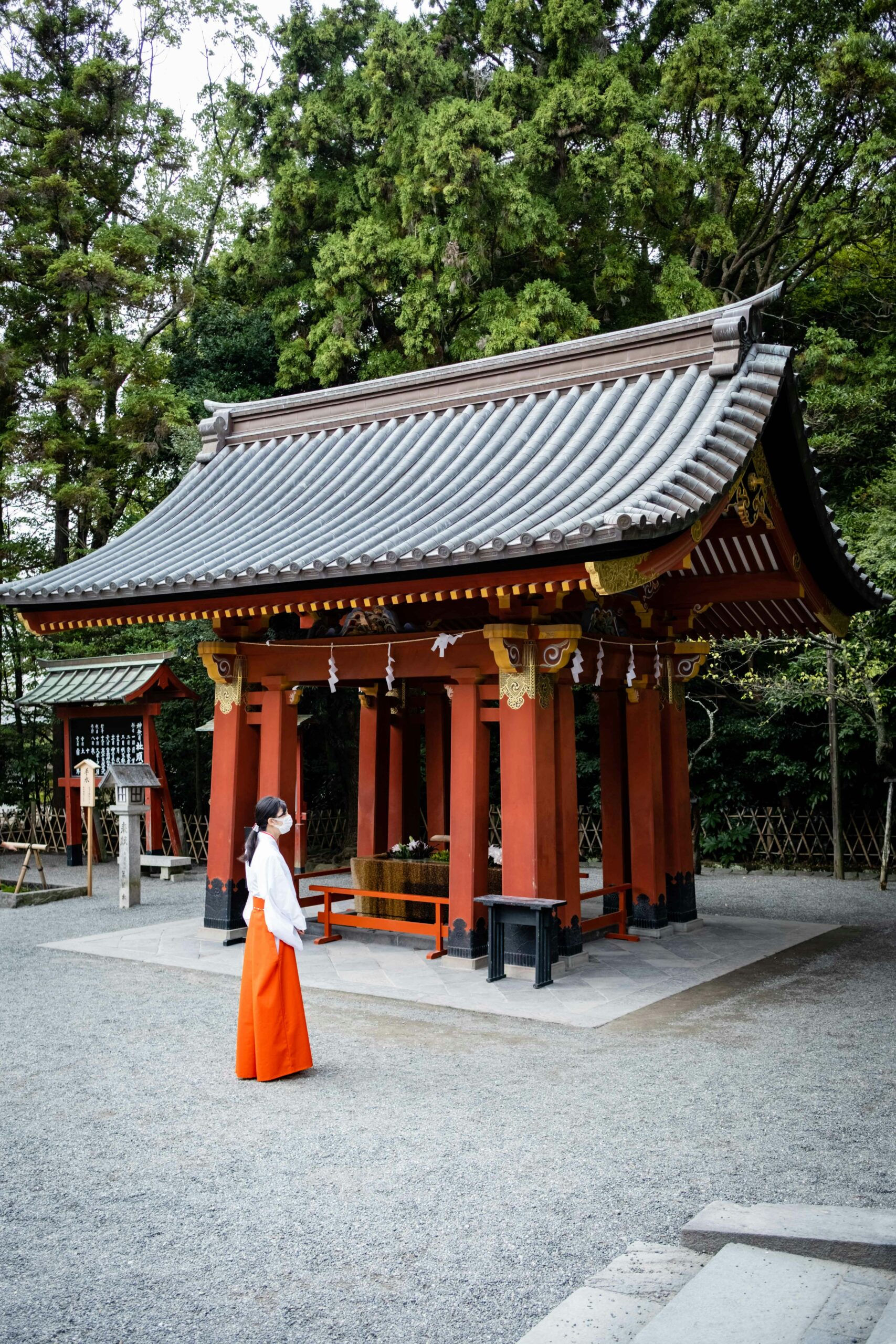
The Spiritual Foundation of Kimono Rituals
Understanding the Sacred Nature of Kimono
The practice of wearing kimono during traditional festivals in Kyoto is far more than dressing up—it’s a spiritual preparation that connects the wearer to centuries of Japanese heritage. Each element of the kimono carries symbolic meaning:
Color Symbolism in Festival Kimono:
- Deep indigo (kon): Represents protection and spiritual cleansing
- Vermillion red (shu-iro): Symbolizes life force and celebration
- Pure white (shiro): Indicates purification and new beginnings
- Golden yellow (kin-iro): Represents prosperity and divine blessing
The ritual of donning a kimono begins with purification of mind and body. Traditional practitioners often perform a brief meditation or offer a small prayer before touching the garment, acknowledging the sacred nature of what they’re about to wear.
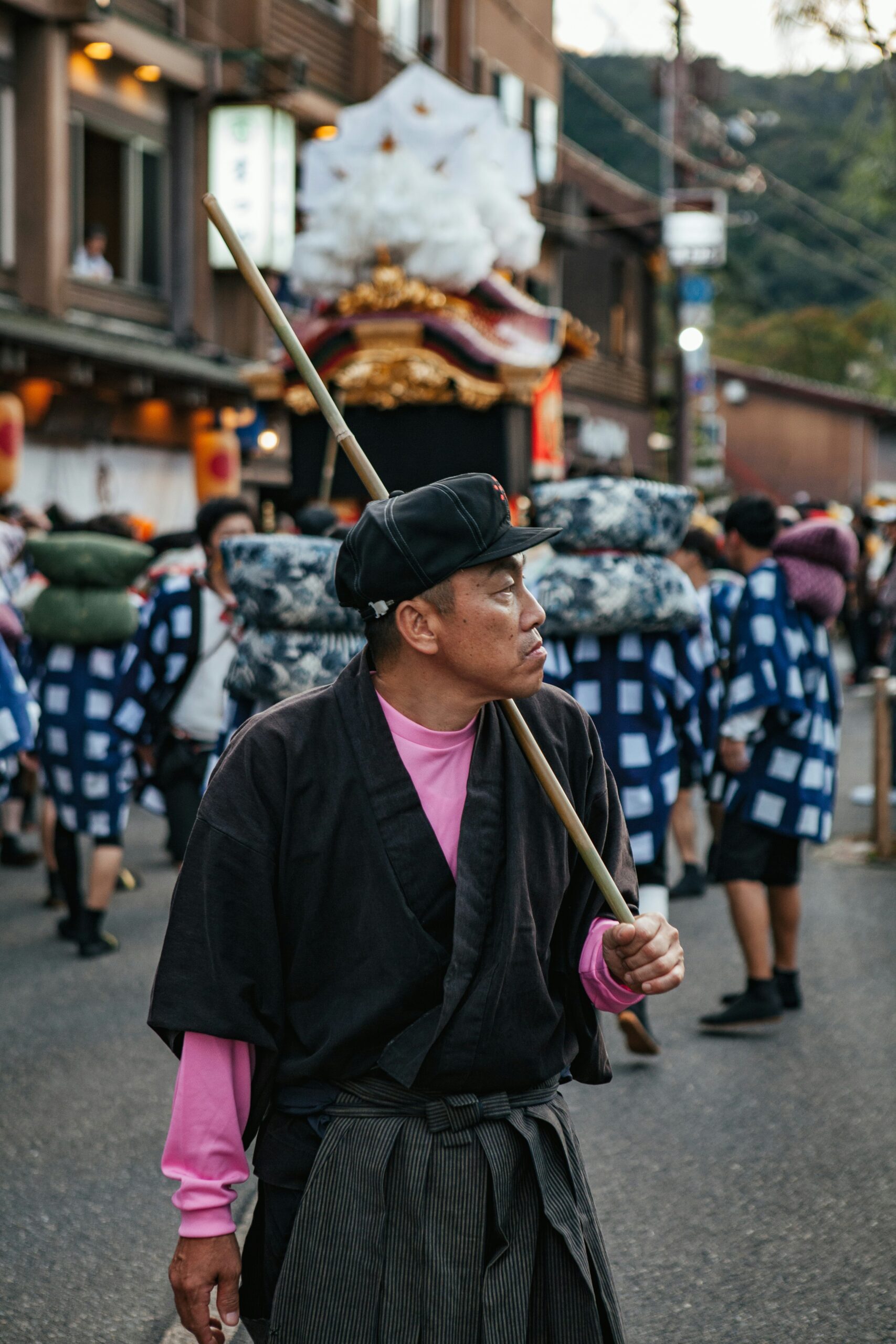
The Ceremony of Dressing: Kitsuke Ritual
The kitsuke ceremony—the art of properly wearing kimono—follows precise steps that have remained unchanged for centuries. This ritual typically takes place in the early morning hours before festivals, creating an atmosphere of anticipation and reverence.
The Seven Sacred Steps of Kitsuke:
- Hadajuban Application: The innermost layer represents purity of intention
- Nagajuban Placement: The under-kimono establishes spiritual foundation
- Kimono Draping: The main garment embodies cultural identity
- Obi Positioning: The sash symbolizes life’s binding commitments
- Obiage Arrangement: The cord represents spiritual elevation
- Obijime Securing: The decorative rope ensures spiritual protection
- Final Adjustments: Perfecting the harmony between inner self and outer expression
Each step requires mindful attention, transforming the act of dressing into a moving meditation that prepares both body and spirit for the sacred festivities ahead.
Kyoto’s Major Festivals and Their Kimono Traditions
Gion Matsuri: The Crown Jewel of Kimono Ceremonies
Gion Matsuri, Kyoto’s most famous festival held every July, represents the pinnacle of kimono ritual traditions. Dating back over 1,150 years, this festival transforms the ancient capital into a spectacular display of cultural heritage where kimono wearing reaches its most refined expression.
Men’s Festival Kimono Rituals:
- Traditional dark colors (navy, black, deep brown) dominate
- Hakama (formal divided skirts) are worn with precise folding techniques
- Geta (wooden sandals) must be blessed before wearing
- Hair styling follows ancient samurai traditions
Women’s Festival Kimono Rituals:
- Seasonal patterns must align with festival timing
- Kanzashi (hair ornaments) are selected based on lunar calendar
- Makeup application follows geisha-inspired techniques
- Walking patterns mirror traditional dance movements
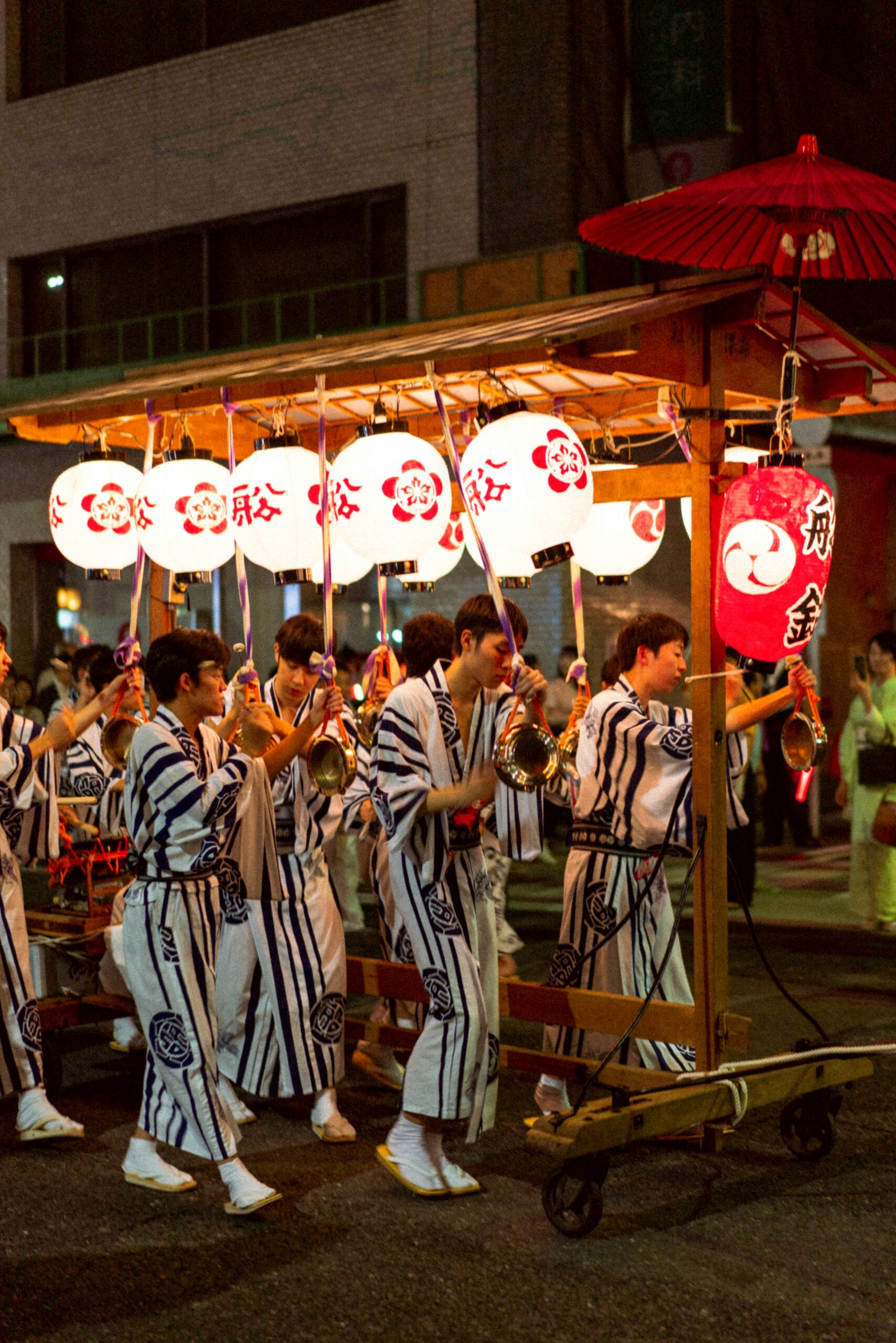
The preparation ritual for Gion Matsuri begins three days before the festival, with participants engaging in purification ceremonies, dietary restrictions, and meditation practices that honor the festival’s spiritual origins.
Aoi Matsuri: The Festival of Leaves and Sacred Processions
Aoi Matsuri (Hollyhock Festival) in May showcases a different aspect of kimono rituals, emphasizing connection with nature and seasonal awareness. Participants wear kimono decorated with seasonal motifs that reflect the natural world’s awakening.
Sacred Elements of Aoi Matsuri Kimono Rituals:
- Morning dew collection for fabric blessing
- Incorporation of fresh hollyhock leaves in hair arrangements
- Use of natural dyes that change color throughout the day
- Procession formations that mirror ancient court ceremonies
The ritual preparation involves gathering natural elements at dawn, blessing the kimono with morning mist, and arranging hair ornaments using only materials collected from sacred temple grounds.
Jidai Matsuri: Historical Eras Through Kimono Evolution
Jidai Matsuri (Festival of Ages) in October presents a unique opportunity to witness kimono rituals spanning different historical periods. Each participant embodies a specific era, requiring mastery of that period’s particular dressing and behavioral customs.
Era-Specific Kimono Rituals:
- Heian Period (794-1185): Multi-layered juni-hitoe with court ceremonies
- Kamakura Period (1185-1333): Warrior-influenced practical elegance
- Edo Period (1603-1868): Merchant class innovations and urban sophistication
- Meiji Period (1868-1912): Western influence integration with traditional forms
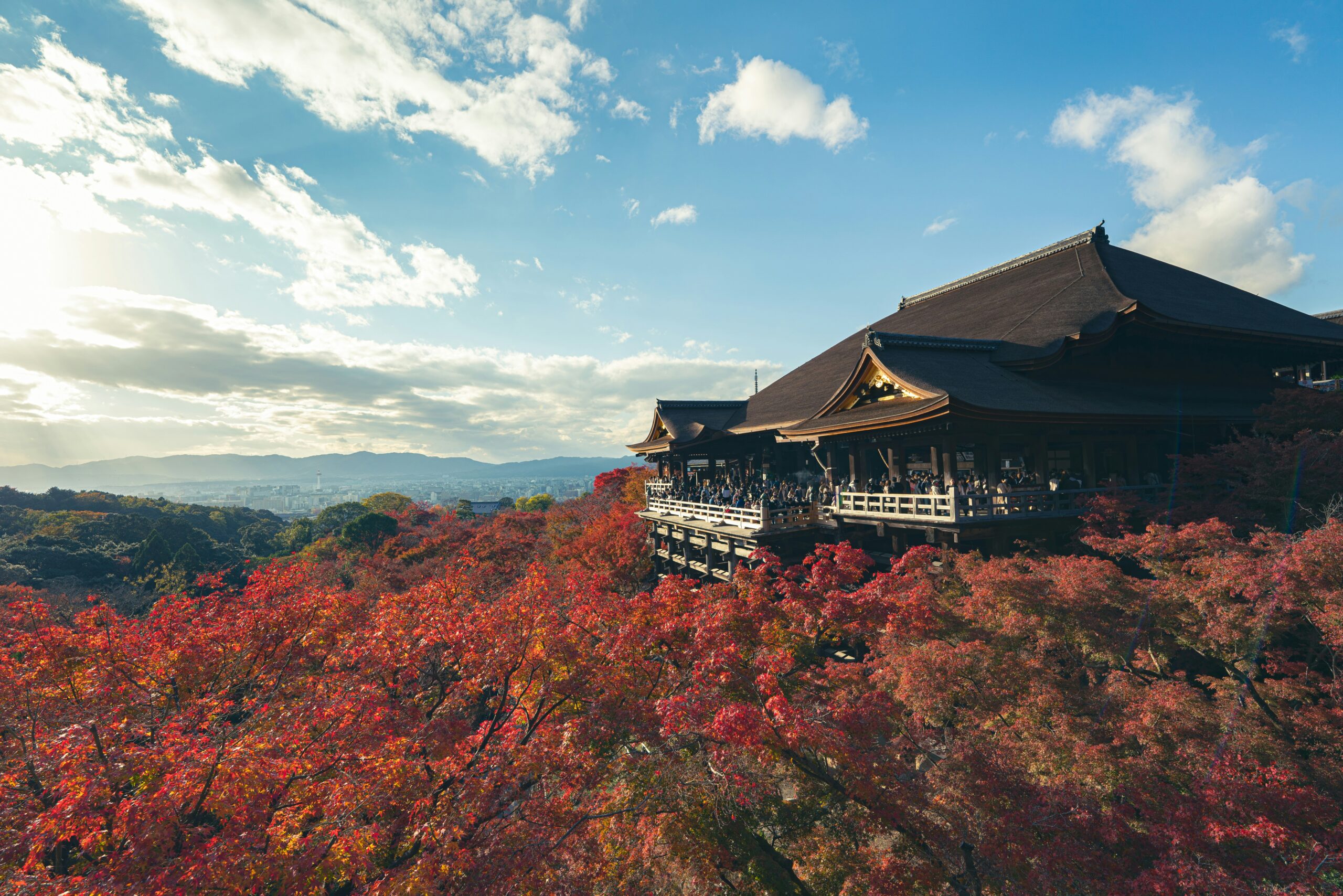
Seasonal Variations in Kimono Festival Rituals
Spring Cherry Blossom Ceremonies
Hanami season brings special kimono rituals that celebrate renewal and beauty’s transient nature. The practice of hana-kimono (flower kimono) involves:
Cherry Blossom Kimono Rituals:
- Dawn visits to temple gardens for pattern inspiration
- Incorporation of falling petals into obi arrangements
- Color coordination with specific cherry blossom varieties
- Sunset photography sessions capturing ephemeral beauty
Participants often engage in collaborative dressing ceremonies where friends and family assist in the kimono ritual, strengthening community bonds while honoring tradition.
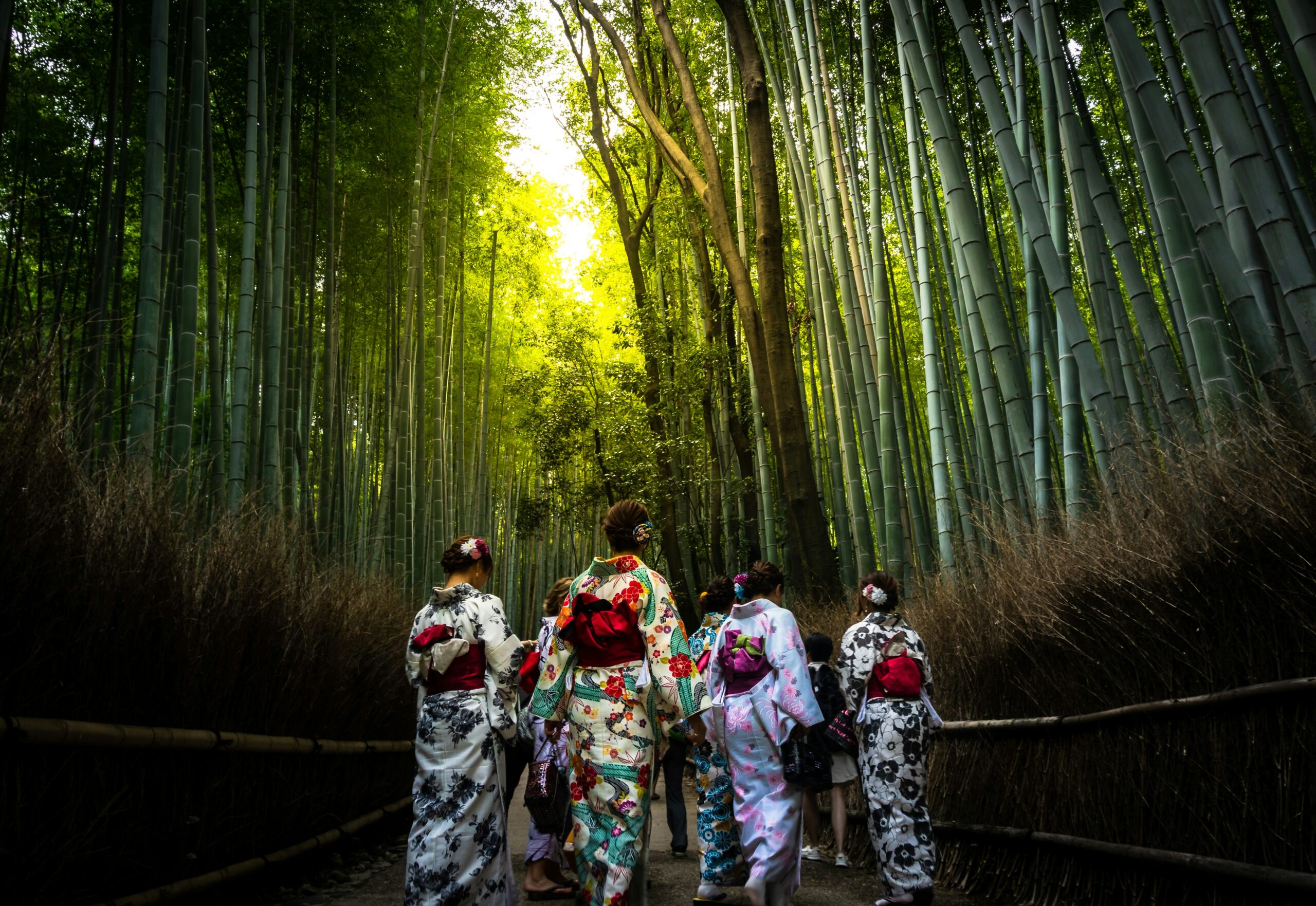
Summer Festival Night Celebrations
Natsu-matsuri (summer festivals) feature lightweight yukata and special cooling rituals:
Summer Kimono Cooling Rituals:
- Pre-dawn fabric preparation with mountain spring water
- Strategic fan placement and movement techniques
- Breathing exercises coordinated with fabric flow
- Evening lantern light ceremonies for optimal photography
Autumn Leaf Viewing Traditions
Momiji-gari (autumn leaf viewing) creates opportunities for some of Kyoto’s most photogenic kimono rituals:
Autumn Kimono Color Harmony Rituals:
- Morning maple leaf collection for color matching
- Sunset timing coordination for optimal lighting
- Traditional tea ceremony integration
- Calligraphy practice with seasonal poetry
Capturing the Sacred: Photography and Kimono Rituals
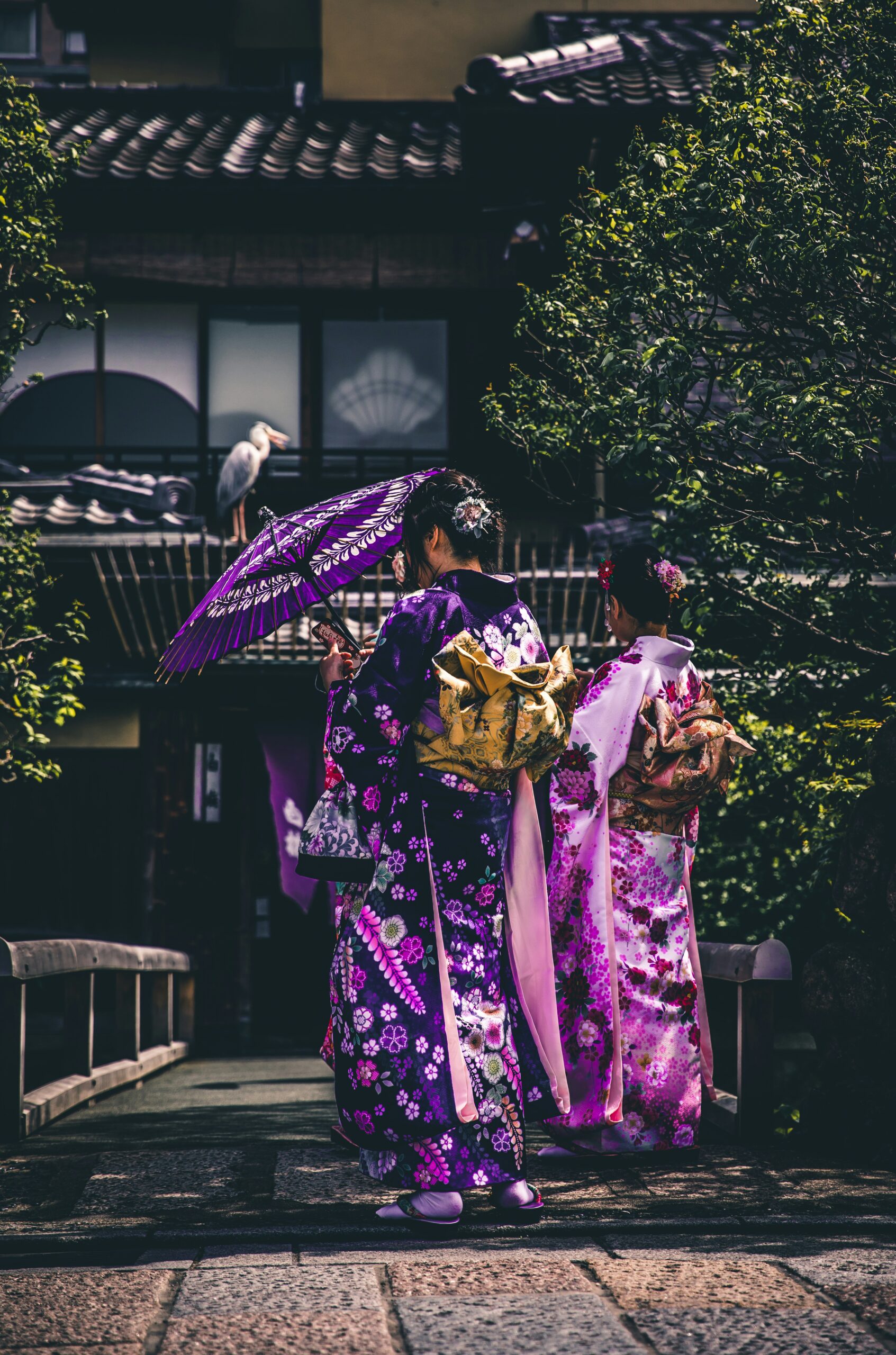
The Art of Festival Photography in Kyoto
Documenting these sacred kimono rituals requires sensitivity, respect, and artistic vision. Professional festival photography in Kyoto combines technical expertise with cultural understanding, creating images that honor both the tradition and the individuals participating in these ancient ceremonies.
Essential Elements for Kimono Festival Photography:
- Golden hour timing: Early morning and late afternoon light enhance fabric textures
- Cultural context: Including traditional architecture and natural elements
- Movement capture: Documenting the flowing grace of kimono in motion
- Detail focus: Showcasing intricate patterns, accessories, and craftsmanship
- Environmental integration: Blending subjects with Kyoto’s historic landscapes
For those seeking to preserve these precious moments professionally, AllPhoto Kyoto specializes in capturing the authentic beauty of traditional Japanese ceremonies, offering expert photography services that respect cultural protocols while creating stunning visual memories.
Respectful Photography Practices
Cultural sensitivity in kimono festival photography requires understanding traditional etiquette:
Photography Protocol Guidelines:
- Always request permission before photographing individuals
- Maintain respectful distance during sacred ceremonies
- Avoid flash photography during ritual moments
- Focus on artistic composition rather than intrusive close-ups
- Honor the spiritual nature of the events being documented
Regional Variations: Kyoto’s Unique Kimono Traditions
Gion District Specialties
The Gion district maintains the most authentic kimono ritual traditions, with practices passed down through generations of geiko and maiko:
Gion-Specific Rituals:
- Ozashiki preparation: Formal entertainment kimono selection
- Seasonal transition ceremonies: Marking calendar changes with clothing shifts
- Master-apprentice dressing rituals: Knowledge transfer through hands-on teaching
- Evening transformation ceremonies: Preparation for traditional performances
Arashiyama Bamboo Grove Ceremonies
Arashiyama’s bamboo groves provide a mystical setting for unique kimono rituals:
Bamboo Grove Rituals:
- Morning mist ceremonies: Using natural fog for purification
- Wind pattern awareness: Coordinating movement with bamboo rustling
- Shadow play traditions: Using filtered light for dramatic effect
- Seasonal bamboo blessing: Honoring the grove’s spiritual energy
Kiyomizu Temple Protocols
Kiyomizu-dera Temple area maintains strict kimono protocols for festival participation:
Temple-Specific Requirements:
- Purification washing: Hands and mouth cleansing before dressing
- Prayer integration: Including temple visits in preparation routine
- Respectful positioning: Avoiding inappropriate locations for photography
- Traditional pathway usage: Following ancient pilgrimage routes
Modern Adaptations While Preserving Tradition
Contemporary Kimono Rental Culture
Modern kimono rental services in Kyoto have democratized access to these beautiful traditions while maintaining ritual authenticity:
Modern Ritual Adaptations:
- Professional assistance: Expert dressers help maintain traditional standards
- Educational components: Learning about cultural significance during rental
- Photography integration: Coordinating with professional photographers
- Seasonal planning: Timing visits with optimal festival periods
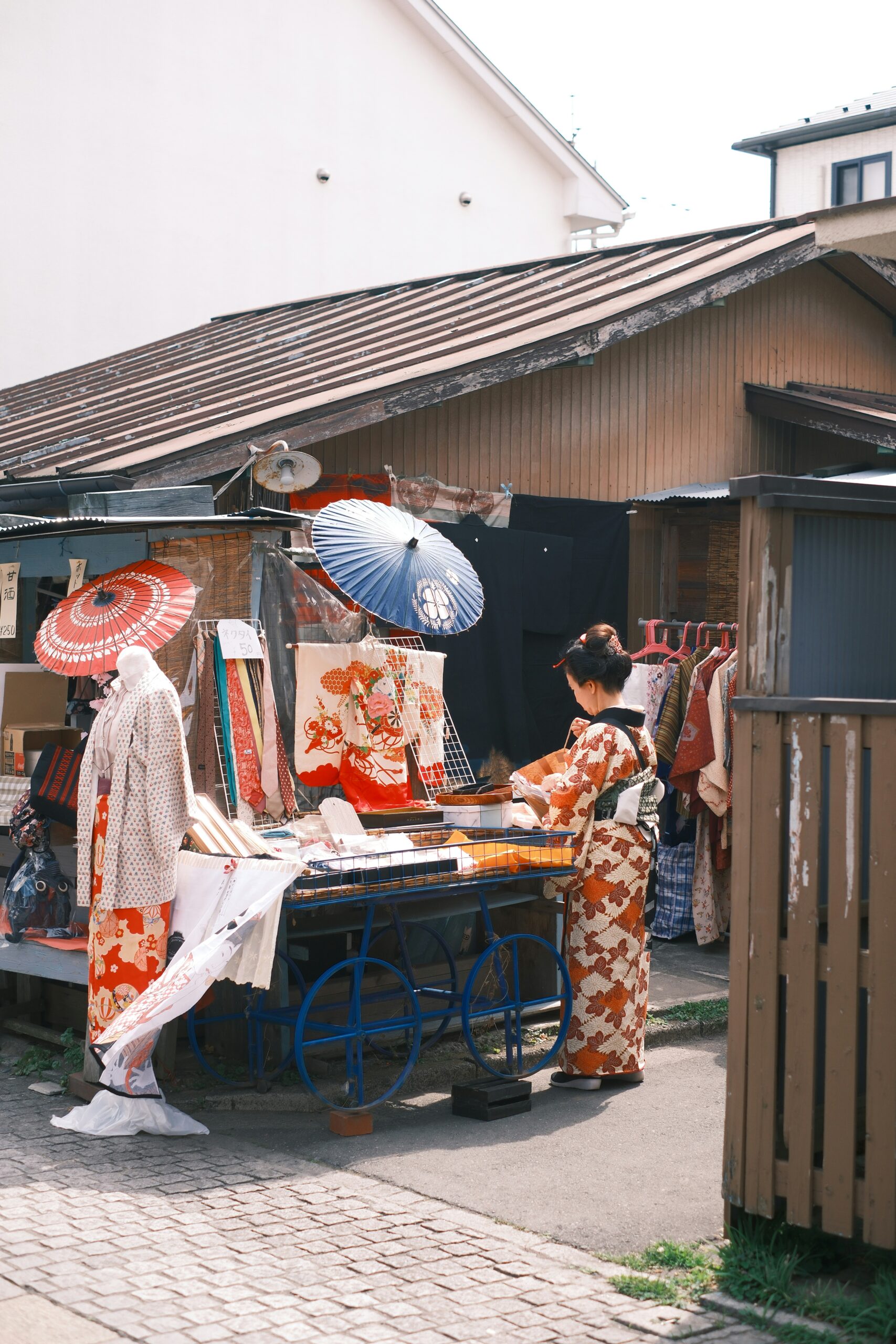
Technology and Tradition Balance
Digital documentation of kimono rituals serves preservation purposes while respecting traditional values:
Technology Integration Benefits:
- Cultural education: Sharing knowledge with global audiences
- Preservation efforts: Documenting techniques for future generations
- Artistic expression: Creating new forms of cultural appreciation
- Community building: Connecting practitioners worldwide
The Artistic Elements of Kimono Festival Rituals
Pattern Significance and Selection
Traditional patterns (mon-yo) carry deep symbolic meanings that influence ritual practices:
Sacred Pattern Categories:
- Natural elements: Flowers, animals, and seasonal motifs
- Geometric designs: Representing harmony and balance
- Spiritual symbols: Buddhist and Shinto religious imagery
- Historical references: Connecting to specific cultural periods
Color Harmony Principles:
- Seasonal appropriateness: Matching natural color cycles
- Spiritual significance: Aligning with ceremonial purposes
- Personal energy: Selecting colors that enhance individual aura
- Community harmony: Coordinating within group participation
Historical Context and Cultural Preservation
Ancient Origins of Kimono Rituals
Historical development of kimono rituals traces back over 1,000 years:
Evolution Timeline:
- Heian Period Origins: Court costume formalization
- Kamakura Simplification: Practical adaptations for broader use
- Edo Period Democratization: Merchant class adoption and innovation
- Meiji Period Challenges: Western influence and cultural preservation
- Modern Revival: Contemporary appreciation and global recognition
UNESCO Recognition and Cultural Protection
International recognition of these traditions emphasizes their global cultural value:
Preservation Efforts:
- Master craftsperson programs: Training new generations
- Documentation projects: Recording techniques and knowledge
- Cultural exchange: Sharing traditions with international audiences
- Educational initiatives: Teaching respect and understanding
Participating in Kimono Festival Rituals
Preparation Guidelines for Visitors
International visitors can respectfully participate in these traditions with proper preparation:
Visitor Preparation Steps:
- Cultural research: Understanding historical and spiritual significance
- Language basics: Learning essential Japanese phrases and etiquette
- Physical preparation: Building stamina for lengthy ceremonies
- Mental readiness: Approaching with respect and open mind
- Professional guidance: Working with experienced cultural guides
Etiquette and Respectful Engagement
Proper etiquette ensures positive experiences for all participants:
Essential Etiquette Rules:
- Silence during ceremonies: Maintaining reverent atmosphere
- Appropriate photography: Following cultural protocols
- Personal space: Respecting traditional distance requirements
- Dress standards: Meeting minimum formality requirements
- Gift giving: Understanding traditional reciprocity customs
Festival Calendar and Planning Guide
Annual Festival Schedule
Planning your kimono ritual experience requires understanding Kyoto’s festival calendar:
Major Festival Timeline:
- January: New Year temple visits and blessing ceremonies
- March: Plum blossom viewing and early spring rituals
- April: Cherry blossom festivals and hanami celebrations
- May: Aoi Matsuri and spring purification ceremonies
- July: Gion Matsuri and summer festival preparations
- October: Jidai Matsuri and autumn leaf viewing
- December: Year-end purification and preparation rituals
Seasonal Highlights:
- Spring: Renewal ceremonies and nature awakening rituals
- Summer: Cooling ceremonies and evening celebrations
- Autumn: Harvest gratitude and color harmony rituals
- Winter: Purification ceremonies and year-end reflection
Professional Photography Services for Your Kimono Experience
Capturing Timeless Memories
Professional documentation of your kimono ritual experience creates lasting memories while respecting cultural traditions. Expert photographers understand the delicate balance between artistic vision and cultural sensitivity, ensuring your images honor both personal significance and traditional values.
Benefits of Professional Photography:
- Cultural expertise: Understanding appropriate timing and locations
- Technical excellence: Utilizing optimal lighting and composition
- Respectful approach: Maintaining dignity of sacred traditions
- Artistic vision: Creating beautiful, meaningful images
- Lasting memories: Preserving precious cultural experiences
For those seeking authentic, respectful documentation of their kimono festival experience in Kyoto, AllPhoto Kyoto offers specialized services that combine technical expertise with deep cultural understanding, ensuring your memories are captured with both beauty and respect.
Conclusion: Embracing the Sacred Art of Kimono
The ancient rituals associated with wearing kimono at traditional festivals in Kyoto represent far more than cultural performance—they embody a living connection to Japan’s spiritual heritage. These ceremonies transform simple acts of dressing into profound moments of cultural communion, where past and present merge in elegant harmony.
Key Takeaways:
- Spiritual significance: Kimono rituals connect wearers to ancestral wisdom
- Cultural preservation: These traditions maintain Japan’s artistic heritage
- Community bonding: Festivals strengthen social connections through shared ceremony
- Personal transformation: Participating in rituals creates profound personal meaning
- Global appreciation: These traditions offer universal lessons in beauty and respect
Moving Forward: As we witness these magnificent traditions, we become part of their continuing story. Whether as respectful observers or active participants, our engagement helps ensure these sacred arts continue to flourish for future generations.
The elegant dance of silk and ceremony, the whispered prayers of preparation, the shared joy of festival celebration—these elements combine to create experiences that transcend mere tradition, becoming transformative encounters with the deepest aspects of Japanese culture.
In Kyoto’s ancient streets, where every stone holds memory and every temple bell calls across centuries, the ritual of kimono wearing continues to weave its magic, inviting all who witness it to discover the profound beauty that emerges when reverence meets artistry in perfect harmony.
Ready to capture your own kimono festival experience?
Visit AllPhoto Kyoto to discover how professional photography can preserve these precious cultural moments with beauty, respect, and artistic excellence.
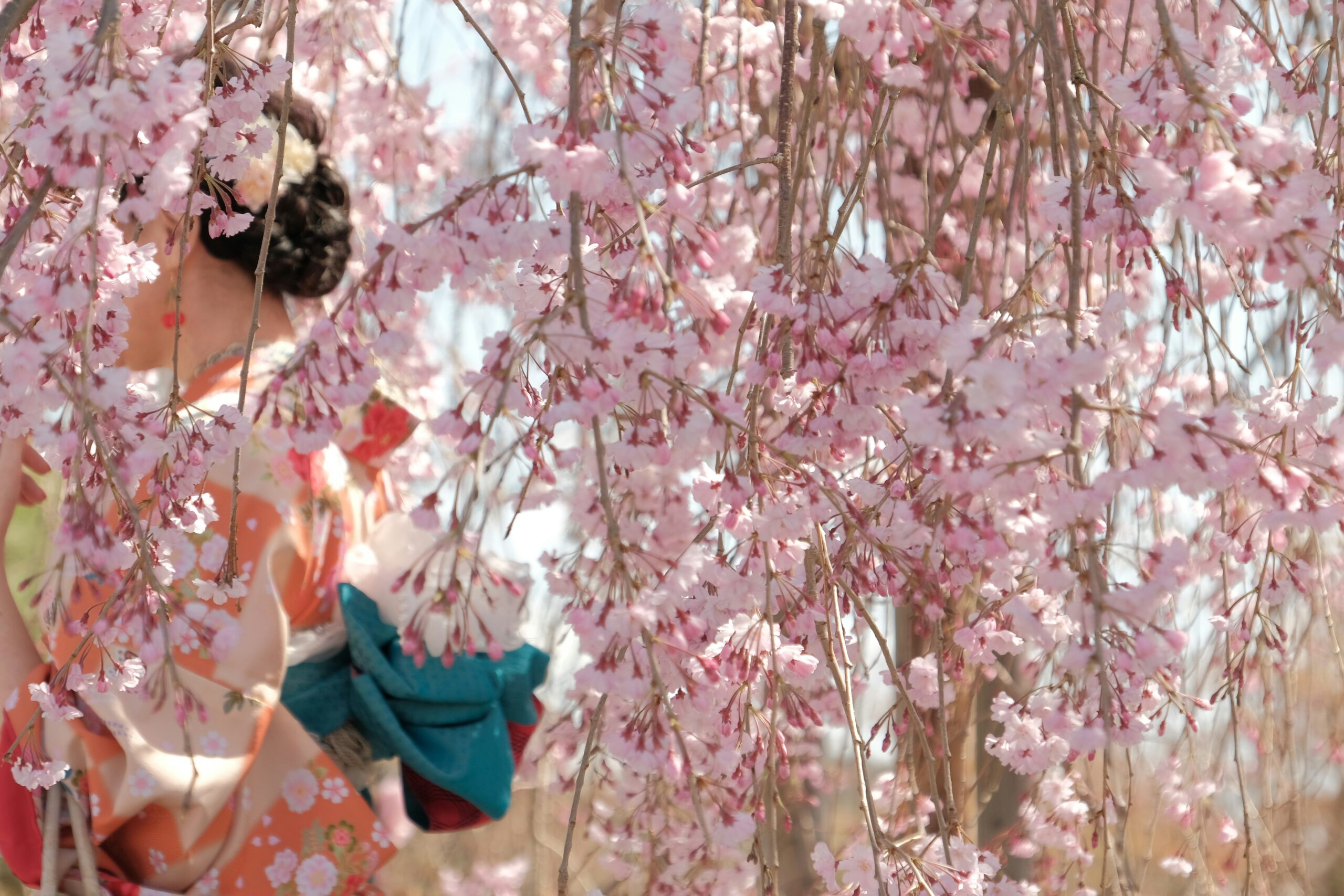


コメント